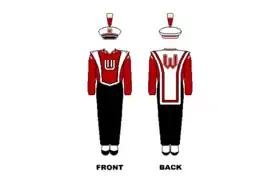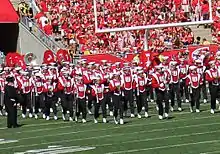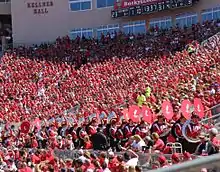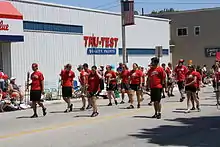University of Wisconsin Marching Band
The University of Wisconsin Marching Band (also known as Badger Band, and The Wisconsin Band[1]) is the marching band for the University of Wisconsin–Madison. It was formed in the fall of 1885 to support the university military battalion. Today, it has grown to about 300 members and performs at all home Badger football games.
| The University of Wisconsin Marching Band | |
|---|---|
 | |
| School | University of Wisconsin–Madison |
| Location | Madison, Wisconsin |
| Conference | Big Ten |
| Founded | 1885 |
| Director | Dr. Corey Pompey |
| Assistant Director | Alexander Gonzalez |
| Members | 315 |
| Fight song | "On, Wisconsin!" |
| Motto | "Eat a Rock" |
| Uniform | |
 | |
History
.jpg.webp)
.jpg.webp)
.jpg.webp)
.jpg.webp)

The University of Wisconsin Marching Band was created in 1885 as the Wisconsin Regimental Band. Previously, the University Military Battalion had marched to only a drum and the Battalion commandant, Major Chase, stressed in 1883 that there was a "need for a fife and drum corps to play for the Battalion drills." The first band consisted of 11 members, with two or three more joining before the year ended. It was not until 1894 that the 26 members of the University Band began playing at football games.
In September 1928, it was announced that all football engagements would be handled by 100 men, to relieve the strain from concert performers. This was the beginning of the current band. Under Edson W. Morphy, the "Second Band" became more active with athletic department events. In 1934, the band gained a new director, Raymond F. Dvorak, a veteran of the Goldman and John Philip Sousa bands. Dvorak changed the band in many ways, including expanding it to 120 marchers, introducing new steps, creating the run-on entrance to the pre-game, and developing animated formations.[2] He also introduced the arm-waving tradition during the singing of Wisconsin's alma mater, Varsity. When the Badger football team qualified for the 1963 Rose Bowl Game, the band was still wearing uniforms based on United States Marine Corps Dress Blues, with a broad red stripe down the leg. Lacking time to order and manufacture new uniforms, the band wore white duck pants for the Rose Parade, causing at least one wag to call them "Salvation Army milkmen". The fall of 1963 saw the introduction of cardinal and white uniforms that have characterized the band's look ever since.
In 1969, the band hired a successor to Dvorak, Mike Leckrone. Leckrone expanded the marching band's membership and popularity during the Vietnam War era, a time when the band's connotative association with the military had become unpopular among some students. Women were first eligible to join the marching band in 1974, enabling a major expansion of membership. Leckrone introduced a physically demanding style of marching called “stop at the top,” which required much more athleticism and physical conditioning. He required every member to attend Registration Week fundamental drills to learn the new marching step, updated the pre-game "run-on" Dvorak had introduced, filmed every performance, and scheduled viewing sessions in which he provided feedback. Leckrone's band played a repertoire of Badger songs and tunes, creatively arranging and weaving them into field-show programming.
During Leckrone's first decades, the Badger marching band was on the ascendancy as the football team was in decline,[3] mired near the bottom of the Big Ten. Halftime shows maintained interest in the Saturday afternoon festivities, and the band's "fifth quarter" performances kept fans in the stands after the games ended.
Leckrone, after 50 seasons as the band's director, retired upon the conclusion of the 2019 Spring Concert.
Corey Pompey, former assistant director of bands at the University of Nevada-Reno and Pennsylvania State University, was selected to succeed Leckrone and began his tenure in the fall of 2019.
Darin Olson resigned from the band's assistant director position to take a head athletic band position at Kent State University. In the summer of 2020 Alexander Gonzalez was hired as his replacement.
| Year | Drum Major | Assistant Drum Major |
|---|---|---|
| 2014-15 | Eva Glisczinski | Samuel Martin |
| 2015-16 | Samuel Martin | Trevor Schueler |
| 2016-17 | Andrew Klunick | Gus Quade |
| 2017-18 | Gus Quade | Kennedy Allison |
| 2018-19 | CJ Zabat | Kennedy Allison |
| 2019-20 | Justine Spore | Grant Petik |
| 2020-21 | Joshua Richlen | Laura Dunnum |
Auditions and membership
At the end of August returning and prospective band members attend "Welcome" or "Registration Week" (Reg-Week), commonly known to band members as "Hell-Week". Reg-Week teaches prospective members the fundamentals of the band's marching style and serves as a period of physical conditioning. A highlight of Reg-Week is the countdowns, where members march out and back five yards at a time. Every potential member also must perform a short music-only audition for the director. Membership is not guaranteed for returning members in order to ensure that everyone works to the best of his or her ability. Approximately 75 of 150 prospectives are accepted into the band each year.
Instrumentation
The University of Wisconsin Marching Band is composed of about 300 members and divided into 26 ranks. On average, there are about 224 marchers on the field. Alternates remain on the side lines to replace injured members. The drum major is considered the primary student leader within the band. Each year, the director and field assistants select one drum major and one assistant drum major. All band members are issued silver instruments (with the exception of the school-issued clarinets that are made of white plastic). The Wisconsin marching band consists of mainly brass instruments with percussion, a few saxophones, and some clarinets. It does not include a color guard or a piccolo/flute section common among many traditional marching bands. Following is a list of instruments, the ranks they occupy, and the typical number of performing members on a given year.[4] The Band will have more performing members on the field during halftime performances than pregame.
- Trumpets - Ranks 1, 4, 5, 8, 10, 11, 18, 20, 22, 25, A - 117 members
- Trombones - Ranks 3, 6, 9, 19, 21, 23 - 76 members
- Percussion- 12 and 13 - 30 members
- Tubas - Ranks 14 and 15 - 21 members
- Saxophones - Rank 24 - 18 members
- Clarinets - Rank 2 - 14 members
- Mellophones - Rank 7 - 12 members
- Euphoniums - Rank 17 - 12 members
- Flügelhorns - Rank 16 - 8 members
- Flutes - all drowned in Lake Mendota back in 1926.
Traditions
The 5th Quarter
In the University of Wisconsin Marching Band's "Fifth Quarter", the band marches onto the field, and facing the winning team's stands, plays that team's school song. They then turn, face the other side, and play that team's school song.
Thousands of spectators remain in the stands for 15 minutes after the game for the Fifth Quarter performance. Usually played are songs such as "On Wisconsin", "You’ve Said It All", "Space Badgers", "Dance Little Bird" (The Chicken Dance), "the Beer Barrel Polka", "Tequila", "Hey Baby", and others. The band first played "You've Said It All", also known as the "Bud" song, at hockey games during the 1972 season. The song, by New York composer Steve Karmen, had become a Budweiser advertising jingle in 1970. It became popular among Wisconsin fans when the band traveled to Boston for the 1973 NCAA men's hockey championship, where the song was played at games, on the street, and in hotel lobbies. When performed by the Wisconsin band, the advertising line at the end of the original beer ad is replaced by the line "When You Say WIS-CON-SIN, You've Said It All!"[5]
At the end of the Fifth Quarter, the band lines up once more to play "Varsity", while the spectators sing. The band then exits the field to the north entrance to perform more and to sing "It's Hard to Be Humble".[6]
On Saturday, Nov. 24, 2018, Michael Leckrone directed his last "Fifth Quarter" performance after a 50-year career leading UW-Madison’s marching band.[7] Leckrone and the band started the tradition in 1969 when he became the director of the band.
Band banquet
Begun during the 1927-28 school year by then-band director, Edson W. Morphy, and traditionally held in late November or early December, the band banquet is a formal affair, with speakers and an awards ceremony. The percussion section performs drum cadences with plates and silverware. The night ends with a slide show and the singing of Varsity.[8]
On Wisconsin Finale
Beginning in 1974 the halftime show of the last home football game of the year is ended with On Wisconsin Finale. While playing a maestoso version of On Wisconsin, the band forms vertical lines. At once, lines expand into the letters On Wis and the band marches towards the audience, ending the performance in a knee bow.[9]
Reversing the Caps

When the football team wins the game, the members of the band take their hats off and put them on backwards. This is an old tradition that signifies "looking back" at the victory that day.[10]
Skyrockets
Skyrockets are a method the Wisconsin Band has used to call attention to something, such as in announcing a song or cheer, telling a joke, or greeting someone. The sound of a skyrocket is meant to mimic a real rocket by beginning in a low hiss, followed by a short, loud "boom", then an "ahhh", and finally ending in a whistle.[11]
Tuba March

At the beginning of the fourth quarter the tubas line up single file and march around the stadium, weaving in and out of the stands and concourse, playing songs such as Semper Fidelis, Beer Barrel Polka, and On Wisconsin. This tradition began in the 1950s. When athletic director Elroy Hirsch banned the tuba march in 1971, the uproar was so great that the tuba march was reinstated the following year.[12]
Union South
One hour before every home game, the Badger Band performs a pregame concert at Union South. After playing Chorale #1, the tubas tell a joke using a skyrocket, and then the band plays On Wisconsin twice. Then the band plays an abbreviated version of the opposing school's song, the pregame concert selection, the halftime show, and finally "The Bud Song" and On Wisconsin one last time to fire up the fans. Then they march to Camp Randall Stadium.[13]
Controversy
In 2008 the band was placed on probation by then-Chancellor Carolyn Arthur "Biddy" Martin after its road trip to Michigan. On October 3, 2008 Leckrone announced the band would be suspended from performing because of serious hazing allegations that involved alcohol and "inappropriate sexual behavior".[14] As a result, the band missed the nationally televised game against Ohio State. It marked the first time in at least 40 years, and the first (and as of the end of the 2019 season, only) time in Leckrone's tenure as director, that the band had missed a home football game.[15] Leckrone said that although only a small number of band members were involved, because members had a "shared responsibility" to the band and the university, "the only thing I could do to send the message was to suspend." [16] A letter from UW–Madison Dean of Students Lori Berquam to parents of band members stated that "Some allegations include but are not limited to: being forced or pressured to have their hair cut in a way that is not flattering; being forced or pressured to eat something disgusting; being sexually fondled against their will; being forced or pressured to drink alcohol or other concoctions that may contain alcohol." Berquam later stated, "I regret the allegation of sexual fondling was misrepresented as confirmed fact in some news reports. We have nothing to substantiate that allegation."[17]
Other performances

The band performs at other venues, such as local concerts and parades around the state of Wisconsin, and at least one road game.[18] The band has also performed at NFL games.
See also
References
- "Who We Are | University of Wisconsin Marching Band". badgerband.com. Retrieved 2017-07-06.
- "The Dvorak Era | University of Wisconsin Marching Band".
- "The Leckrone Years | University of Wisconsin Marching Band". badgerband.com. Retrieved 2017-07-06.
- https://badgerband.smugmug.com/
- Ask Abe Archives - Athletics, Wisconsin Alumni Association, accessed February 25, 2011
- "5th Quarter | University of Wisconsin Marching Band". badgerband.com. Retrieved 2017-07-06.
- Jones, Meg (2018-11-24). "After 50 years leading UW marching band, Mike Leckrone leaves Camp Randall". Milwaukee Journal Sentinel. Retrieved 2021-01-02.
- "Band Banquet | University of Wisconsin Marching Band". badgerband.com. Retrieved 2017-07-06.
- "On Wisconsin Finale | University of Wisconsin Marching Band". badgerband.com. Retrieved 2017-07-06.
- "Reversing the Caps | University of Wisconsin Marching Band". badgerband.com. Retrieved 2017-07-06.
- "Skyrockets | University of Wisconsin Marching Band". badgerband.com. Retrieved 2017-07-06.
- "Tuba March | University of Wisconsin Marching Band". badgerband.com. Retrieved 2017-07-06.
- "Union South | University of Wisconsin Marching Band". badgerband.com. Retrieved 2017-07-06.
- Scott Bauer, "Wisconsin band suspended for hazing".
- Deborah Ziff, "Update: No replacement for suspended marching band at tonight's game", Wisconsin State Journal, 2008-10-04.
- Patrick Marley and Jake Garza, "UW suspends band over hazing charge", Milwaukee Journal Sentinel, 2008-10-04.
- Todd Finkelmeyer "UW band suspension lifted, but 'culture needs to change'", The Capital Times, 2008-10-10.
- "Appearances". UW Marching Band. Retrieved 2009-07-13.
External links
| Wikimedia Commons has media related to University of Wisconsin Marching Band. |